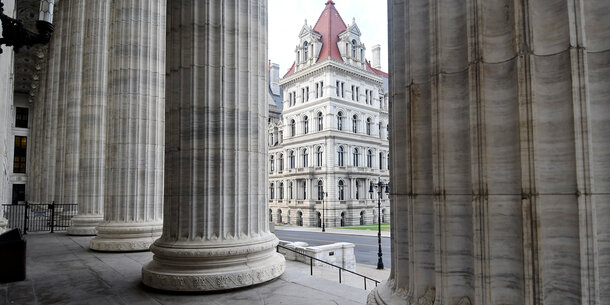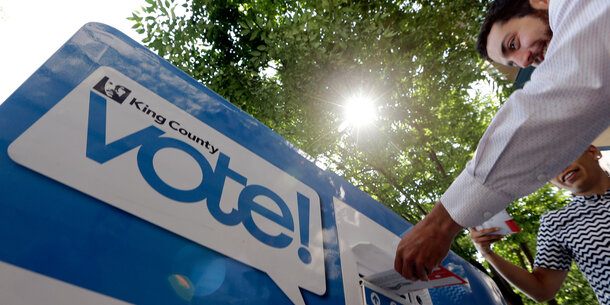This analysis was produced jointly by OpenSecrets and the Brennan Center.
In November, New York launched an innovative public campaign finance program for statewide and state legislative candidates. Our new analysis shows the program’s potential to transform the political landscape by enabling candidates to rely more on small-dollar contributions from constituents and less on big donors and special interests while still raising competitive sums.
To meet that potential, lawmakers and officials would need to ensure adequate funding and sound administration as 2024 candidates weigh whether to join the voluntary program. If they do, the program stands to strengthen connections between elected officials and constituents and boost the clout of local voters.
Here are the key findings of our analysis using 2022 state campaign finance data.
- Campaign financing in New York is dominated by big money. Last year, the 200 biggest donors to candidates gave almost $16 million, more than all 206,000 of the state’s small donors of $250 or less put together.
- In legislative elections, the new public financing program could increase the financial power of small donors sixfold, from 11 percent of all donations in 2022 to as much as 67 percent. The increase is entirely due to small donors who live in each candidate’s district.
- In statewide elections, small donors’ financial power could increase nearly sevenfold, from 6 percent to 41 percent of all campaign funds. The increase is entirely due to small donors who are New York residents.
- Independent expenditures do not affect the viability of public financing, as the program allows candidates to earn sufficient funds to compete.
Campaign Finance Is Dominated by the Biggest Donors
The imbalance between large and small donors is unambiguous. In New York’s 2022 elections, the 200 biggest individual donors to candidates contributed $15.9 million. That rarefied handful of individuals outspent some 206,000 small donors of $250 or less, who together provided $13.5 million. And taking outside spending into account shows the power of big donors far exceeds this estimate. Super PACs — fueled by megadonors and special interests, including some unknown to the public — poured millions into the governor’s race and the most competitive legislative races.
The growing influence of wealthy donors in New York resembles a broader trend nationwide. In 2022, donors fueled a record-breaking $16.7 billion in spending on state and federal elections, with the biggest donors consistently increasing their share since 2010, when the Supreme Court’s Citizens United decision opened the floodgates to big money in politics.
New York’s Innovative Public Financing Program
Starting with the 2024 election cycle, candidates can choose to participate in a system that will boost the small-dollar support they earn from the New Yorkers who will be their constituents if they win. The key elements of this program, explained in detail in this resource, are:
- Matching funds that multiply small donations — Candidates for statewide office can earn $6 in matching funds for every $1 from a New York resident, up to $250. Candidates for the legislature can earn matching funds only for donations from residents of their district, with the smallest amounts matched at the highest ratio: a $12-to-$1 match for amounts up to $50, a $9-to-$1 match on the next $100, and an $8-to-$1 match on the next $100.
- Qualifying criteria — The program avoids wasting funds on frivolous campaigns by requiring participating candidates to prove sufficient public support by raising a threshold number of small donations from constituents. To ensure that less wealthy communities can benefit from the program, candidates in the lowest-income districts face lower qualifying thresholds.
- Caps on public funds, but with the ability to raise and spend more — The public treasury is also protected by limits on the total matching funds each candidate can earn, although participating candidates are free to raise and spend as much private money as they wish in compliance with contribution limits.
- Transparency and oversight — The system requires participating candidates to publicly report their fundraising and spending, and it establishes a strong compliance and enforcement regime.
With this program, New York has accomplished several “firsts” among state-level public financing policies by incorporating features that especially respond to the growing disconnect between campaign financing and representative democracy.
It is the first state system implemented since the Supreme Court’s decision in Citizens United supercharged big money in politics. It is the first to feature a progressively tiered match that amplifies the smallest contributions the most. And it is the first to match only in-district donations for legislative candidates at sufficient ratios to enable candidates to raise competitive sums. In both legislative and statewide races, candidates can earn public funds only by raising small amounts from future constituents, a policy that boosts the influence of local voters at a time when big national donors weigh in on even local races.
In addition, New York has significantly reduced contribution limits — formerly among the highest in the nation — for all candidates, regardless of whether they decide to participate in public financing. Limits decreased for statewide office by almost three-quarters, for senate by nearly half, and for assembly by more than a third.
Modeling the Program’s Effects
Our analysis applies the new program’s policies to fundraising data from the 2022 state elections to project how it can transform the role of money in the state’s politics. The program has the potential to flip campaign finance on its head, changing a system where most of the funding comes from big donors and special interests into one where the greatest share comes from small-donor constituents.
Legislative Races
In New York’s 2022 legislative elections, small donors of $250 or less accounted for only 11 percent of all candidate funding. The bulk of the money came from donors of $1,000 or more and entities like PACs, corporations, and unions, which together provided 69 percent of candidate funds.
Assuming all candidates participated in the new public financing program, small donors and public funds would become the biggest source of funds — 53 percent — even if candidates raised money only from the same donors they did in 2022. The increase would be entirely due to small donors residing in each candidate’s district and the public match. Individual donors of $1,000 or more and donations from entities would account for 39 percent.
But matching funds will provide candidates with a strong incentive to campaign for new small donors in their communities much as they do for votes, so a significant increase in small-donor participation is likely. New York State currently has one of the lowest rates of donor participation in the nation. It would take a twofold increase to bring it in line with the median state. A doubling of donors would also make the state’s rate of giving comparable to that of New York City, where the public financing program has brought about a major increase in donor participation. Therefore, it is reasonable to estimate that the number of small donors would double under the program.
With additional donors added to the analysis, small donors would account for 67 percent of candidate funding, while the share from entities and $1,000-plus donors would amount to only 28 percent. The financial power of small donors would increase sixfold compared to their share without the matching program in 2022.
These results are consistent with a prior Campaign Finance Institute analysis of data from the 2018 elections.
The analysis of 2022 data also shows that candidates who shift to relying on small donors from their districts should be able to compensate for any huge donations lost due to reduced contribution limits. More than 90 percent of major-party general election candidates would raise as much or more money by participating in public financing compared to what they actually raised in 2022, if they qualified for the program and complied with program rules. This is true even if candidates raised money only from the same donors as they did in 2022, although of course, the size of those donors’ contributions and their relative financial power would change under public financing.
Some advocates have expressed concerns that candidates who participate in the public financing program may be swamped by independent expenditures by super PACs, which cannot legally be limited because of Citizens United. An examination of outside spending in the 2022 assembly and senate elections shows this risk is small. As is typical in other jurisdictions, independent expenditures targeted a few competitive races: 75 percent of outside dollars spent in legislative races targeted just 10 percent of districts. Of the 213 contests for assembly and senate, 70 percent saw no independent expenditures at all, and only 24 contests had independent expenditures totaling more than $100,000.
The program offers sufficient resources for candidates to run competitive campaigns. The highest outside spending last year was in Senate District 33, where two super PACs spent more than $900,000 in support of a candidate who lost in the primary. The second-biggest outside spending was in Senate District 50, where outside groups spent approximately $546,000 and $108,000, respectively, on each side of the general election. A senate candidate who raises enough small donations from the district can earn up to $375,000 in public funds for a general election. It is also important to remember that the program does not limit candidates’ ability to keep raising and spending unmatched contributions if they reach their limit on matching funds — a sensible policy choice in the post–Citizens United era. Matching funds only improve the candidates’ financial support in a race that would attract independent spending in any case. At the same time, the incentive to build up a fundraising base within the constituency strengthens the candidates’ political networks to help withstand spending by outsiders.
Statewide Races
In statewide contests, too, the public financing program has the potential to significantly increase the importance of small-donor New Yorkers. Our analysis of 2022 campaign finance data for the four offices — governor, lieutenant governor, attorney general, and comptroller — shows that candidates who choose to focus on smaller donations can raise the great majority of their funds from everyday New Yorkers.
In 2022, small donors accounted for just 6 percent of all statewide candidates’ funds. Individual donors of $1,000 or more and entities contributed 90 percent.
Assuming all candidates participated in the new public financing program, small donors’ share would more than quadruple to 27 percent, even if candidates raised money from the same donors as in 2022. Individual donors of $1,000 or more and entities would account for 72 percent. Projecting twice the number of donors for the same reasons we cited in our analysis of legislative campaigns, small donors’ financial power would increase nearly sevenfold from 2022 levels to 41 percent of all funds raised.
Typical high-dollar fundraising by gubernatorial candidates obscures even greater projections for small-donor importance for other statewide offices. Looking only at lieutenant governor, attorney general, and comptroller candidates, and assuming full participation in the program and twice as many donors, small donations and matching funds would comprise 73 percent of candidates’ funds. Contributions from large donors and entities would amount to only 27 percent.
Independent spenders were highly active in the gubernatorial race, with more than $21 million in expenditures, far outpacing recent elections. But both major-party candidates were able to outspend opposing independent expenditures. The public financing program provides even gubernatorial candidates the means to mount competitive campaigns by earning significant matching funds from everyday New Yorkers, with the ability to continue raising and spending unlimited sums in unmatched donations that comply with contribution limits.
Methodology
This analysis uses data from the 2022 elections, through December 1, 2022, to model the potential effects of the new public financing program and lower contribution limits, following the methods of the Campaign Finance Institute’s study of the 2018 election. Amounts given above the new contribution limits were excluded. Matching funds according to the above formulas were added for matchable donations. Since donations of between $250 and $2,550 would be worth less than a matched $250 donation, all donations in that range were changed to $250 donations. To estimate the new donors incentivized by the system, the analysis doubles each candidate’s number of small donors and assumes new donors will each give $50. Finally, the analysis assumes that all candidates will qualify and participate in the program. Our estimate of the number of small donors is based on evidence that small donors’ average contribution is approximately $40, as explained in a prior analysis. Independent expenditure data was collected from the State Board of Elections independent expenditure portal and political internet digital ads portal.
Brendan Glavin is a senior data analyst at OpenSecrets. Michael Malbin is a professor emeritus at State University of New York at Albany. Ian Vandewalker is a senior counsel in the Brennan Center’s Elections and Government Program.






